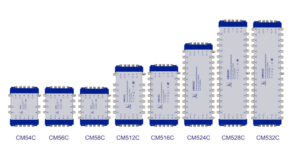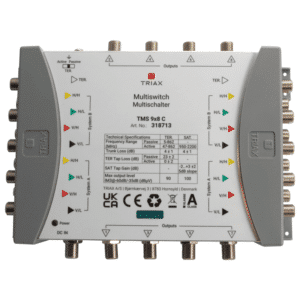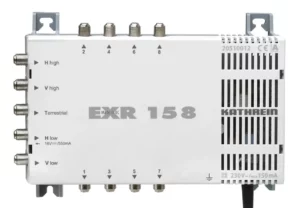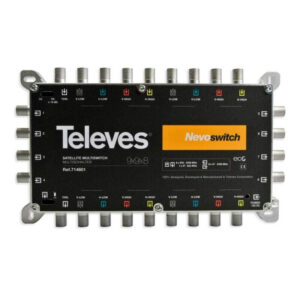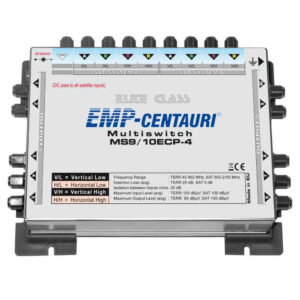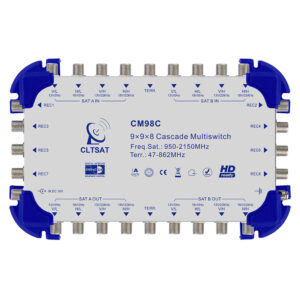In today’s digital era, the satellite and television industry is undergoing unprecedented growth and transformation. With the continuous popularity of digital TV, high-definition TV, and satellite broadcasting technologies, the demand for more diverse program content and higher picture quality is constantly increasing. And in this industry, Sat Multiswitch plays a crucial role as a key technological component.
Sat Multiswitch is a device used for the distribution of satellite and television signals, similar to switches or routers in networks. It allows users to connect multiple satellite receivers and televisions, distributing signals among them to ensure each TV receives high-quality signals. This distribution not only provides greater signal coverage but also ensures signal quality remains unaffected, meeting users’ demands for clear pictures and stable signals.
In the past, people may have only needed to connect one satellite receiver and one TV, but with the continuous improvement and diversification of home entertainment systems, many households now have multiple TVs and satellite receivers. In such cases, the importance of Multiswitch becomes even more prominent. It enables users to effortlessly watch different programs in different rooms without experiencing signal degradation issues due to signal distribution.
Therefore, understanding the role and principles of Sat Multiswitch is crucial for comprehending the operation of the satellite and television industry. This article will delve into the Sat Multiswitch industry overview, the current market situation, and the competitive landscape of related companies, aiming to present readers with a comprehensive industry panorama.
Sat Multiswitch Industry Overview
The satellite and television industry is a vital part of modern society, providing rich entertainment and information resources to people. With years of development, from the initial cable TV to the current digital era, this industry has been innovating and progressing continuously. With the advancement of technology and the changing demands of audiences, this industry still holds infinite possibilities and opportunities.
Sat Multiswitch Technology and Market Demand
As one of the key technologies in the satellite and television industry, Sat Multiswitch plays a crucial role. Its principle involves concentrating signals from different satellite receivers to an output port and then distributing them to multiple TVs or other terminal devices. This technology enables users to simultaneously watch different programs in different rooms of their homes without the need for multiple independent satellite receivers.
Multiswitch finds widespread application in various types of satellite and television systems. Firstly, it is extensively used in satellite television systems in residential and commercial buildings. Through Multiswitches, users can access different channels in different rooms or tenant units without the need for a separate satellite receiver in each room, thereby saving costs and reducing installation and maintenance complexity.
Additionally, Sat Multiswitches are employed in collective satellite television systems in hotels, hospitals, schools, and other large buildings. These places often require satellite TV signals for a large number of users, and Multiswitches effectively manage and distribute these signals, ensuring a good viewing experience for each user.
With evolving market demands, Sat Multiswitch technology is also continuously advancing. On one hand, as the popularity of high-definition and ultra-high-definition TV grows, there is an increasing demand from users for higher picture quality and clearer signals. Therefore, the next generation of Sat Multiswitch products typically support higher resolutions and broader frequency bands. On the other hand, with the development of smart homes and network integration, Multiswitches are also beginning to integrate with other smart devices to achieve more flexible and intelligent satellite TV systems.
Sat Multiswitch Company Profiles
In the realm of Sat Multiswitch production, several prominent companies hold significant market positions. These industry leaders, renowned for their expertise and innovation, play pivotal roles in shaping the landscape of satellite signal processing technology. Below are detailed profiles of these key players:
Founded in 1969 in Germany, Spaun has established itself as a premier provider of satellite and television signal processing solutions. With decades of experience and a commitment to technological advancement, Spaun has garnered a substantial market share in Europe. The company’s product portfolio encompasses a wide range of sat multiswitches, amplifiers, and distribution systems, catering to both residential and commercial applications.
Founded in Denmark in 1949, Triax has been at the forefront of satellite and television signal processing technology for over half a century. Renowned for its commitment to innovation and reliability, Triax has captured a sizable market share across Europe. The company’s comprehensive range of multiswitch products caters to diverse applications, from residential installations to large-scale commercial projects, ensuring seamless signal distribution and enhanced viewing experiences.
Originating from Germany in 1919, Kathrein boasts a rich heritage as a multinational corporation specializing in satellite and television signal processing equipment. Leveraging its extensive experience and innovative capabilities, Kathrein has emerged as a leading provider of cutting-edge solutions across Europe. The company’s diverse product offerings include multiswitches, antenna systems, and RF components, tailored to meet the evolving needs of broadcasters and telecom operators.
Established in 1958, Televes is a prominent Spanish company renowned for its advanced television and wireless communication solutions. With a strong foothold in Spain and Latin America, Televes has earned a reputation for delivering high-quality products and services to a global clientele. The company’s multiswitch offerings encompass a wide range of configurations, supporting various satellite and terrestrial signal distribution requirements.
Founded in 1995, EMP-Centauri is a company headquartered in the Czech Republic, specializing in the development and manufacturing of electronic and electrical equipment. Its main products include devices for distributing satellite and terrestrial television signals, radio, data, and the Internet.
With over two decades of experience in the satellite and television industry, CLTSAT has emerged as a prominent player in the global market. Headquartered in China, CLTSAT has cultivated strategic partnerships with renowned European brands, leveraging its expertise in manufacturing and distribution. The company’s multiswitch solutions exemplify a fusion of cutting-edge technology and cost-effective performance, making them ideal choices for various deployment scenarios worldwide.
These companies, through their relentless pursuit of excellence and commitment to innovation, continue to drive the advancement of satellite multiswitch technology, meeting the ever-growing demand for high-quality signal distribution solutions.
Market Competition Analysis
The Sat Multiswitch market is a competitive and continuously evolving landscape, with major companies striving to formulate strategies to maintain competitiveness and expand market share. Here is an analysis of the competitive landscape in the Multiswitch market:
Positioning and Market Share of Major Companies:
Companies such as Spaun, Triax, Kathrein, Televes, EMP-Centauri and CLTSAT are key players in the Multiswitch market, boasting extensive product lines and global market coverage.
These companies typically hold varying degrees of market share in different regions, with some dominating the European market while others lead in other regions.
They maintain their competitive edge by offering high-quality products, continuous innovation, and robust customer service.
New Entrants in the Market:
Despite the relative maturity of the Multiswitch market, there are still newcomers attempting to enter this field. These new companies may seek to disrupt market monopolies by offering competitively priced products or leveraging new technologies to attract a portion of the customer base.
However, entering this market is not easy, as it requires substantial technological prowess, production capabilities, and sales channels, as well as competition with existing major companies.
Potential Impacts:
The emergence of new entrants may disrupt market monopolies, prompting existing major companies to intensify efforts in product innovation and service quality enhancement to maintain competitiveness.
Simultaneously, competition from new entrants may compel existing major companies to adjust their strategies, including price reductions, market expansion, and strengthened brand promotion.
Overall, the presence of new entrants in the market may intensify competition in the Multiswitch market, but it may also bring positive effects by stimulating innovation and improving product quality, fostering positive impacts on the industry’s development as a whole.
Technological Trends and Future Prospects
Conclusion
As a key technology in the satellite and television industry, Sat Multiswitch not only continuously innovates in technology but also faces fierce competition in the market. Through in-depth exploration of Multiswitch technology, market, and competition, we can better understand the industry’s development trends and prospects, providing reference and guidance for the industry’s continued development and innovation.





